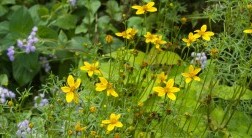Want to grow water-lilies and other beautiful aquatic plants at home but don't have space for a permanent water feature? Cultivate them in pots instead. With watertight containers, some compact aquatic-plant varieties, and a little know-how, you can create a dazzling summer water-garden display. Below is a design for a potted water garden composed of sun-loving emergent and floating aquatic species.
To maintain a healthy aquatic environment, it's important to include floating plants such as water-lilies (Nymphaea) alongside emergent plants, because they filter sunlight and thus minimize the growth of algae. Free-floaters like fairy moss (Azolla) and mosaic plant (Ludwigia) also provide temporary cover while other aquatics—particularly water-lilies—grow in. Though not pictured here, submerged aquatic plants such as wild celery (Vallisneria americana) should also be added to help oxygenate the water. Fish can be added to control pest insects.
Many aquatic plants require richly organic soil, but this is difficult to re-create in a pot. Use nonorganically amended clay soil instead and feed your plants with fertilizer tablets, available from water-garden supply stores. Aquatic species have varying planting depths (see descriptions below); you can create different soil gradients by layering bricks underneath. You'll need to dismantle your potted garden before first frost. For details on how to overwinter aquatics indoors, see the BBG handbook The Potted Garden.

Container A
- Nymphaea 'Perry's Baby Red' (water-lily)
This small, heavy bloomer produces dark green foliage and slightly fragrant deep wine-red cup-shaped summer blossoms. Planting depth: 6 to 18 inches. - Nelumbo 'Chawan Basu' (sacred lotus)
Growing two to three feet tall, this lotus boasts large, bluish-gray, oval-shaped leaves. White blossoms, delicately edged with pink, appear from July to September. Planting depth: 6 to 12 inches. - Acorus gramineus 'Variegatus' (Japanese rush)
This upright, green and white grass-leafed aquatic grows up to a foot tall. Planting depth: 1 to 4 inches. - Juncus effusus 'Spiralis' (corkscrew rush)
A curiously contorted marshland plant, it bears dark green needlelike leaves and grows up to 18 inches tall. Planting depth: 1 to 6 inches. - Azolla filiculoides (fairy moss)
This small, free-floating aquatic forms a dense, mosslike mat on the surface and changes from green to brick-red as the season progresses.
Container B
- Nymphaea 'Joanne Pring' (water-lily)
The young leaves on this miniature aquatic are plum-colored. It produces tiny, fragrant deep pink star-shaped summer blooms. Planting depth: 6 to 12 inches. - Sagittaria latifolia (American arrowhead)
An upright native plant, it grows up to two feet tall and produces wide arrowhead-shaped leaves. Clusters of yellow-centered white flowers appear from summer through fall. Planting depth: 3 to 6 inches. - Typha minima (dwarf cattail)
This Eurasian cattail grows up to 30 inches tall and produces narrow linear leaves. Small, dark brown cattails appear in summer. Planting depth: 1 to 4 inches. - Ludwigia sedioides (mosaic plant)
This aquatic spreads diamond-shaped red and green leaves in a four- to six-inch-wide lacy cluster across the water's surface. It bears small, floating bright yellow cup-shaped flowers in fall. Planting depth: 6 inches.



